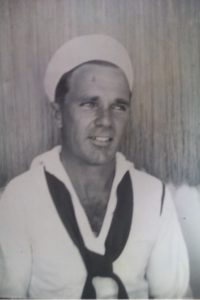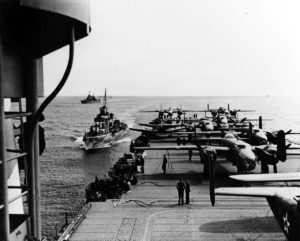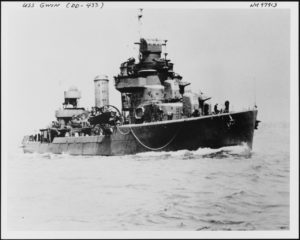How a 32-year-old “Old Man” inspired his shipmates on the USS Gwin
 Within a few minutes after I finished a radio interview on a Colorado station, I got a note on my website from a Charles Frazier. Mr. Frazier, a Navy veteran himself, wanted to tell me the story of a great uncle he never met, Delbert Benton Connor.
Within a few minutes after I finished a radio interview on a Colorado station, I got a note on my website from a Charles Frazier. Mr. Frazier, a Navy veteran himself, wanted to tell me the story of a great uncle he never met, Delbert Benton Connor.
Delbert was one of three sons of the Connor family from Kemp , Texas. Growing up on a farm, Delbert, or “Deb” as he was known, did alright for himself for a while, running a hunting and fishing camp for wealthy Dallas lawyers. According to Deb’s parents (Mr. Frazier’s grandparents), he was a likable young man who the lawyers appreciated. They talked about backing him if he wanted to go back to school and get an education that would allow him to go to law school.
But, once the Depression hit, even the lawyers were without much money. Ded did not get that dream of going back to school. But he was a hard worker. He found a job and saved his money, even buying the family’s first radio and later a truck when his parents had been using mules and wagons for transportation.
When the war came, Deb joined the Navy, even though he was in his late 20’s, nearly a decade older than most young recruits. Though he was not an experienced seaman himself, the other, younger crewmen looked up him. Deb told them stories of his family’s cotton farm, of his beautiful sisters, and of his brothers. One of his brothers made a living riding bulls in rodeos. That brother joined the Navy and became a flight instructor. He likely was the inspiration for Deb to join the Navy.
Deb was assigned to the USS Gwin (DD-433), a Gleaves class destroyer. Sixty-six were built, one of the classes that preceded the introduction of the Fletcher class.
The Gwin escorted the aircraft USS Hornet  (that’s the Gwin getting close to the Hornet) on its mission to deliver General Jimmy Doolittle’s B-25 bombers close to Japan. During the Battle of Midway, the Gwin rescued many of the men when the aircraft carrier USS Yorktown was hit by torpedoes. Her first engagement with the Japanese came during the Battle of Guadalcanal on Nov. 14, 1942, when she boldly attacked a Japanese cruiser. She took two cruiser hits near the stern and retreated.
(that’s the Gwin getting close to the Hornet) on its mission to deliver General Jimmy Doolittle’s B-25 bombers close to Japan. During the Battle of Midway, the Gwin rescued many of the men when the aircraft carrier USS Yorktown was hit by torpedoes. Her first engagement with the Japanese came during the Battle of Guadalcanal on Nov. 14, 1942, when she boldly attacked a Japanese cruiser. She took two cruiser hits near the stern and retreated.
The Gwin made her way back to Mare Island in Vallejo, California, for more permanent repairs. Deb took leave to visit his parents. At some point over the Christmas holiday, he signed over his Navy insurance policy to them. When his father took Deb back to the train, he cried, somehow knowing that he would not see his son again.
On the night of July 13, 1943, the Gwin was part of the American force during the Battle of Kolombangara. While the Japanese had not yet installed their own radar, they had developed a device that detected American radar. Without the Americans seeing them on radar, the Japanese launched 31 Type 93 torpedoes (after the war they were nicknamed Long Lances). One of those Type 93s hit the Gwin amidships. The Gwin herself stayed afloat, but was sunk by an American destroyer so she would not be a shipping hazard, or recovered by the Japanese.
Of her 16 officers and 260 crew, just two officers and 59 crewmen were lost. But one was Deb.
After the war, one seaman who survived the war came to Texas to find Deb’s parents. The sailor explained that the torpedo had blown him into the air, but left him without a scratch. He sought out Deb’s parents to tell him that Deb was an inspiration to the younger men on the Gwin. He was handsome, strong and capable, just the type of man they wanted to grow up to be if they survived the war.
Delbert Benton Conner was 32 years old when he was killed. He was an old man compared to the other sailors on the Gwin,  but he was their hero.
but he was their hero.
I want to thank Charles Frazier, a hook runner on the carrier USS Kitty Hawk during the Vietnam War, for sharing the stories of the great uncle he never met. It is men willing to go to war who preserve the peace for the rest of us.
I have just finished reading Tincans and greyhounds. You did not mention the 2nd nights basttle when the USS Washington and South Dakota with four destroyers met the Japanese battle ship Kirishima and sank her. The destroyers were Walke,Benham ,Preston, and Gwin were damaged early by torpedos that could have been used against the Washington and S. Dakota.
I missed that action, Richard. I will look it up. Thanks for pointing it out to me. So many actions going on out in the Pacific compared to very little surface actions happening in the Atlantic. That was something that surprised me -how much the action differed from ocean to ocean. Thanks for writing.